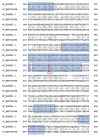Emergence of Drift Variants That May Affect COVID-19 Vaccine Development and Antibody Treatment
- PMID: 32357545
- PMCID: PMC7281497
- DOI: 10.3390/pathogens9050324
Emergence of Drift Variants That May Affect COVID-19 Vaccine Development and Antibody Treatment
Abstract
New coronavirus (SARS-CoV-2) treatments and vaccines are under development to combat COVID-19. Several approaches are being used by scientists for investigation, including (1) various small molecule approaches targeting RNA polymerase, 3C-like protease, and RNA endonuclease; and (2) exploration of antibodies obtained from convalescent plasma from patients who have recovered from COVID-19. The coronavirus genome is highly prone to mutations that lead to genetic drift and escape from immune recognition; thus, it is imperative that sub-strains with different mutations are also accounted for during vaccine development. As the disease has grown to become a pandemic, B-cell and T-cell epitopes predicted from SARS coronavirus have been reported. Using the epitope information along with variants of the virus, we have found several variants which might cause drifts. Among such variants, 23403A>G variant (p.D614G) in spike protein B-cell epitope is observed frequently in European countries, such as the Netherlands, Switzerland, and France, but seldom observed in China.
Keywords: COVID-19; SARS-CoV-2; antibody; convalescent plasma; genomic drift; immune escape; spike protein; vaccine; variant.
Conflict of interest statement
The authors declare no conflicts of interests pertaining to this work.
Figures
References
-
- Safety and Immunogenicity Study of 2019-Ncov Vaccine (Mrna-1273) to Prevent Sars-Cov-2 Infection. [(accessed on 22 March 2020)]; Available online: https://ClinicalTrials.gov/show/NCT04283461.
LinkOut - more resources
Full Text Sources
Other Literature Sources
Research Materials
Miscellaneous


